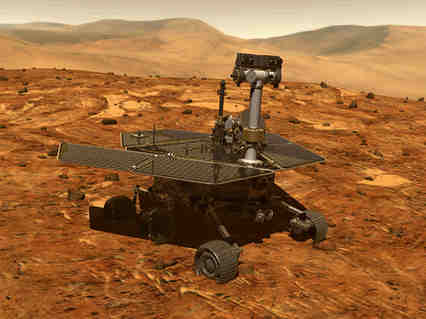美国宇航局正在筹划一个名为“百年星航”的项目,计划在时机成熟时将载人航天器发送至火星,并让宇航员在那里定居,最终将火星拓展为人类的另一个领地。据悉,美国宇航局埃姆斯研究中心已得到100万美元的资金启动该项目。华盛顿州立大学的研究人员表示,从技术上来说,送宇航员到火星是可实现的,但是载人航天器往返火星的项目在短期内还无法实现,而如果只是将宇航员单程送往火星的话,不但能够大幅度减少相关开支,同时还能够开启人类长期定居火星的研究旅程。
“百年星航”的初步设想是向火星派驻4名志愿宇航员永久定居于火星,他们将定期获得来自地球的物资补给,但同时也要想办法在这颗红色星球上“自食其力”。等到这个定居点能够完全实现自给自足的时候,就可以为今后更大规模的领土拓展做服务基地。

 |
|
NASA is planning a one-way mission to Mars in a program called 'Hundred Years Starship' in which, a manned spacecraft will take astronauts to Mars and leave them there forever. |
NASA is planning a one-way mission to Mars in a program called 'Hundred Years Starship' in which, a manned spacecraft will take astronauts to Mars and leave them there forever.
NASA Ames Director Pete Worden revealed that one of NASA's main research centres, Ames Research Centre, has received 1 million dollars funding to start work on the project.
Washington State University researchers had said that while technically feasible, a manned mission to Mars and back is unlikely to lift off anytime soon and so, a manned one-way mission to Mars would not only cut the costs by several fold, but also mark the beginning of long-term human colonization of the planet.
Mars is by far the most promising for sustained colonization and development because it is similar in many respects to Earth and, crucially, possesses a moderate surface gravity, an atmosphere, abundant water and carbon dioxide, together with a range of essential minerals.
"One approach could be to send four astronauts initially, two on each of two spacecraft, each with a lander and sufficient supplies, to stake a single outpost on Mars. A one-way human mission to Mars would be the first step in establishing a permanent human presence on the planet," said Dirk Schulze-Makuch, a Washington State University associate professor.
Colleague Paul Davies, a physicist and cosmologist from Arizona State University, added that they aren't suggesting that astronauts simply be abandoned on the Red Planet for the sake of science; in fact they propose a series of missions over time, sufficient to support long-term colonization.
The authors proposed that the astronauts would be re-supplied on a periodic basis from Earth with basic necessities, but otherwise would be expected to become increasingly proficient at harvesting and utilizing resources available on Mars.
Eventually they envision that outpost would reach self-sufficiency, and then it could serve as a hub for a greatly expanded colonization program.
First, an appropriate site for the colony would be selected, preferentially associated with a cave or some other natural shelter, as well as other nearby resources, such as water, minerals and nutrients.
"Ice caves would go a long way to solving the needs of a settlement for water and oxygen. Mars has no ozone shield and no magnetospheric shielding, and ice caves would also provide shelter from ionizing and ultraviolet radiation," said Schulze-Makuch.
They added that in addition to offering humanity a "lifeboat" in the event of a mega-catastrophe on Earth, a Mars colony would provide a platform for further scientific research.
Schulze-Makuch and Davies acknowledge that such a project would require not only major international cooperation, but a return to the exploration spirit and risk-taking ethos of the great period of the Earth''s exploration.
"Informal surveys conducted after lectures and conference presentations on our proposal have repeatedly shown that many people are willing to volunteer for a one-way mission, both for reasons of scientific curiosity and in a spirit of adventure and human destiny," they wrote.
相关阅读
(Agencies)

(中国日报网英语点津 Helen 编辑)